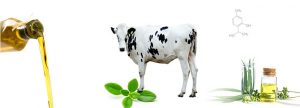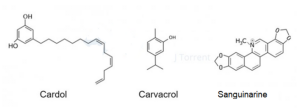 16 Aug 2022
16 Aug 2022
Plant derived additives are an ever growing alternative within the animal feed industry. However sometimes their classification is somewhat deficient. Adequate additive utilization begins with the use of appropriate terminology for each product. The following entry aims to establish basic definitions and differences between essential oils, functional oils, botanical(plant derived) and phytogenic products.
Introduction
Alternative products extracted from plants have appeared on the feed additive market with greater strength as a result of growing restrictions on antibiotic use. Unfortunately, different nomenclatures have been used to define these products, without taking into account that some of the adopted terms are not synonymous and that their incorrect use can lead to erroneous descriptions of the product. The food additive market must treat these products like any other conventional drug, requiring information regarding their composition, activity and establishing quality controls for them. Therefore, these products must be clearly defined in order for them to be adequately incorporated.

Essential oils
According to some website definitions, an essential oil is “a concentrated hydrophobic liquid from plants, containing volatile chemical compounds that are easily evaporable at normal temperatures.” The term “essential” is not used in the same sense as when talking about an amino acid or an essential fatty acid (necessary for animals). It is used in the sense that it contains the essence of a plant’s fragrances. Interestingly, when analyzing the chemical composition of these, they are neither oils nor fatty acids, as they only have a hydrophobic quality. Some common examples of essential oils used in animal feed are: orange peel, oregano, thyme, rosemary, and cinnamon oil.
The most common active compounds of such oils are thymol, carvacrol, cinnamaldehyde or limonene. Some commercial products are enriched or formulated with synthetically manufactured active compounds (rather than naturally extracted) to ensure product composition quality. Most of them are all marketed as essential oils.

Functional oils
Functional oils are those that have properties beyond their energy value (Bess et a., 2012). These activities vary depending on the type of oil. These include, but are not limited to, antioxidant, antimicrobial and/or anti-inflammatory properties.
All essential oils are functional oils, but not all functional oils are essential oils, as many functional oils are not volatile or fragranced.
Examples of this are castor oil, cashew peel oil and medium-chain fatty acids, which are hydrophobic compounds, but are not volatile and do not contain a fragrance. Therefore, they cannot be classified as essential oils. Functional oils may or may not be chemical oils. For example, castor oil and medium-chain fatty acids are triglycerides or fatty acids while cashew peel oil is a mixture of alkylphenols and their polymers. This highlights the wide variety of chemical compounds that are present within these products.
Botanical or phytogenic products
Botanicals orphytogenic products are synonymous and refer to the whole or processed parts of a plant, such as the roots, leaves or bark (Díaz-Sánchez et al., 2015). The terms “botanical” or “phytogenic compound” would also include all functional oils and as explained above, all essential oils would also be included within the group of functional oils.
Figure 1. Illustration of terminology used to describe essential oils, functional oils, and botanical or phytogenic products.

Botanical or phytogenic products also include non-hydrophobic compounds such as fructooligosaccharides (also derived from plants). This example shows the great variety of substances within this group, both from a chemical standpoint and in regards to their mechanism of action.
The importance of using the right terminology
Using the right term to describe a product goes beyond using good scientific terminology. As it represents the first step in making the right decision regarding which product is the most appropriate. Phytogenic compounds are very different and their activities also vary greatly. No one would venture into choosing an antibiotic by chance to prevent or treat any disease. A good professional will decide upon an antibiotic, based on the type of compound (for example, a beta-lactam, a macrolide or an ionophore) that is considered the most suitable to treat the pathology under consideration. This same logic should apply to phytogenic compounds. For example, thymol and carvacrol (present in oregano) are different from cardol and cardanol (present in cashew peel oil) and are all different from sanguinarine (present in the Macleaya cordata plant).
Figure 2. Comparison of the chemical structure of three phytogenic products.

Conclusion
It is very important that consumers demand that suppliers of this type of products offer clear information regarding their composition, and activity. As well as requesting quality controls that validate the use of such products, like it is done with any other “conventional” food additive. This must be the base of a proper and efficient use for these alternative products. Which hold great potential, and will probably become a long lasting asset within the feed additive market.

Source: Abstract taken and modified modified from “Correcta clasificación de los aditivos extraídos de plantas.”
Subscribe now to the technical magazine of animal nutrition
AUTHORS

Nutritional Interventions to Improve Fertility in Male Broiler Breeders
Edgar Oviedo
The Use of Organic Acids in Poultry: A Natural Path to Health and Productivity
M. Naeem
Synergistic Benefits of Prebiotics and Probiotics in Poultry, Swine, and Cattle
Gustavo Adolfo Quintana-Ospina
Hybrid Rye Potential in Laying Hen Feed Rations
Gwendolyn Jones
A day in the life of phosphorus in pigs: Part I
Rafael Duran Giménez-Rico
Use of enzymes in diets for ruminants
Braulio de la Calle Campos
Minerals and Hoof Health in the Pregnant Sow
Juan Gabriel Espino
Impact of Oxidized Fats on Swine Reproduction and Offspring
Maria Alejandra Perez Alvarado